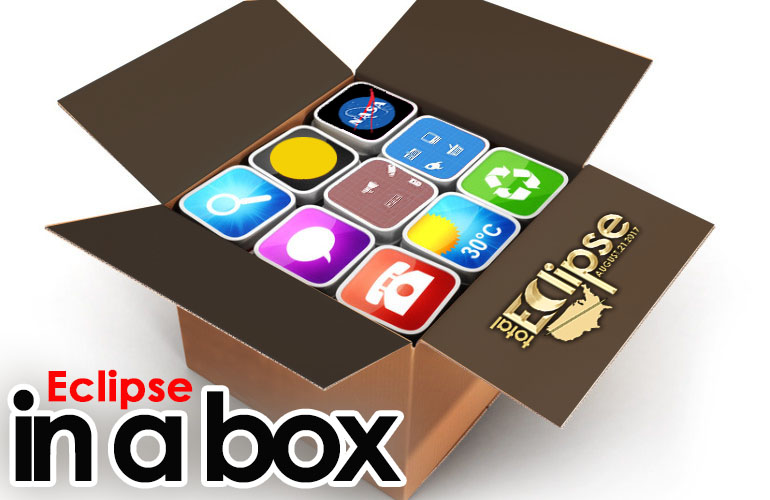Get ready for the Eclipse Across America that occurs on August 21, 2017. All across the USA, everyone can observe a partial to total eclipse of the Sun. To prepare for this rare sight, an Eclipse in a Box is being designed with activities suitable for events, and summer camp programs. People of all ages can learn about the Sun, Moon and Eclipses through fun hands-on STEM activities. Check back on this page for further information as the eclipse approaches!
ECLIPSE BOX ACTIVITIES
LEARN ABOUT THE SUN
LIVING IN A BUBBLE: MAPPING MAGNETIC FIELDS
Age: ES, MS, HS
Materials: Small compass, magnet, (paper, tape, pen or pencil)
We live in a large magnetic bubble generated by the Sun, called the “heliosphere”. The Earth also generates a magnetic field that is similar in structure to the field generated by a bar magnet. IN this activity, you will draw the structure and direction of magnetic field lines generated by a bar magnet on a piece of paper using a compass to point the way. Once completed, you can add another magnet and draw the resulting field. This exercise emphasizes the magnetic field environment around the Earth and the Sun. A cell phone with a compass app can also be used.
SUNBURN: ULTRAVIOLET LIGHT DETECTORS
Age: ES, MS, HS
Materials: 500 UV beads , 100 Chenille Stems, (sun screen)
Most of the light in the universe is invisible to our eyes. We are essentially blind! Light just outside the visible, violet part of the EM spectrum, called “ultra violet” light is produced by the Sun. Fortunately, most of it is filtered out by our atmosphere but some gets through. These rays are responsible for sunburns at the beach! In this activity, you will use specially coated UV beads, threaded onto pipe cleaners, to detect the presence of UV light from the Sun and other sources. As an extension activity, you can test the efficacy of different sunscreens sprayed on UV beads.
SEEING THE INVISIBLE: INFRARED LIGHT DETECTORS
Age: MS, HS ES
Materials: (Cell phone, TV remote)
The Sun produces a wide range of electromagnetic energy from long wavelength Radio Waves to very short wavelength Gamma Rays. Most of this “light” is undetectable with just our eyes so we must build detectors to sense it. Some man-made objects such as TV remote controls, produce infrared light – light that is just outside of the visible red part of the spectrum. In this activity, you will turn your cell phones into infrared detectors capable of sensing the invisible IR signals from regular TV remote controls.
A “LIGHT” BREAKFAST: CEREAL BOX SPECTROMETERS
Age: MS, HS
Materials: Diffraction Grating, (Cereal Box, tape, scissors, construction paper
The Sun and, in fact, all objects in the universe emit light…even you! Scientists use an instrument called a spectrometer to separate the light into its component parts. By observing the components of light, scientists can explore the physical properties of celestial objects. In this activity, you will construct a cereal box spectrometer and use it to tell the difference between incandescent light bulbs and gas emission (fluorescent) light bulbs. You will learn how astronomers use spectrometers to explore planets and stars. An extension activity, building a reflection spectrometer to measure the Sun’s absorption spectrum is included.
IT’S PIZZA TIME: BUILD A SOLAR OVEN
Age ES, MS, HS
Materials: (Cardboard pizza box , Box knife or scissors, Aluminum foil, tape, Plastic wrap or heavy-duty or freezer zip lock bag, Black construction paper, Newspapers, Ruler, or wooden spoon), Thermometer
Energy from the Sun reaches us each day. Some of it is reflected by clouds, snow, and Earth. Some is absorbed by the Earth and sea and then reemitted. In this activity, you will build a working solar oven from a pizza box and aluminum foil that uses reflected light from the Sun to cook food. Recipes for cookies, cinnamon apples, baked potatoes, eggs, and chocolate fondue are included.
WAXING AND WANING: PHASES OF THE MOON
Age: ES, MS, HS
Materials: Large and small Styrofoam balls
The orbits and relative positions of the Sun, Earth, and moon are responsible for some interesting visual celestial phenomena. These include tides, eclipses, and lunar phases. In this activity, you will explore the phases of the moon and learn how and why the moon’s appearance changes over the course of a lunar month.
HOW BIG IS BIG? HOW FAR IS FAR?: SIZE AND SCALE OF THE SUN AND EARTH
Age: MS, HS
Materials: Solar Pizza (Computer, internet access – optional)
How big is the Earth? The Sun? How far away is the Sun? These questions were the holy grail of astronomy during their time. They were solved eventually by a few smart people and a little geometry. In this exercise, you will learn about the relative size of the Sun and Earth and get a real feeling for the distance between them, called the “Astronomical Unit.”
EARTH AS A PEPPERCORN: SIZE AND SCALE OF THE SOLAR SYSTEM
Age: ES, MS, HS
Materials: Sun-any ball, diameter 8.00 inches
Mercury-a pinhead, diameter 0.03 inch
Venus-a peppercorn, diameter 0.08 inch
Earth-a second peppercorn
Mars-a second pinhead
Jupiter-a chestnut or a pecan, diameter 0.90 inch
Saturn-a hazelnut or an acorn, diameter 0.70 inch
Uranus-a peanut or coffee bean, diameter 0.30 inch
Neptune-a second peanut or coffee bean
To include the dwarf planet, Pluto- a third pinhead (or smaller, since Pluto is the smallest “planet”)
The solar system is really big! Flying in a commercial jet air plane, it would take you 17 years just to get to the Sun! In this activity, you will build a scale model solar system with accurate sizes and distances of the Sun and planets, using very small objects.
SUNSET: MEASURING TEMPERATURE AND LUMINOSITY AS THE SUN GOES DOWN
Age: MS, HS
Materials: Light Meter, Thermometer, (cell phone)
In this activity, you will use a thermometer and light meter to observe the changes in temperature and luminosity as the Sun sets.
ECLIPSES - HOW DO ECLIPSES HAPPEN?
Age: ES, MS
Materials: Yard stick, Styrofoam balls, wooden sticks, paper fasteners
A solar eclipse occurs when the moon moves directly between the Sun and Earth. This happens once or twice every year on average, somewhere on the Earth. This activity demonstrates how the Moon’s shadow can fall on only a small part of the Earth.
WHY DON’T ECLIPSES HAPPEN EVERY MONTH?
Age: ES, MS, HS
Materials: NSN Earth-Moon Activity
Solar eclipses occur when the moon moves directly between the Earth and the Sun. Why then, don’t eclipses happen every month? This activity clearly demonstrates how eclipses happen and how they don’t.
WHEN DAY TURNS TO NIGHT: MEASURING LUMINOSITY AND TEMPERATURE DURING AN ECLIPSE
Age: ES, MS, HS
Materials: Thermometer for cell phone, light meter, (cell phone), (paper and pencil) Classroom thermometer
During a total solar eclipse, the sky and all around you becomes dark. It is an eerie feeling! Squirrels thinking that night has fallen begin to bed down for the night. Birds nest. Crickets chirp. In this activity, you will measure the drop in light levels and temperature during totality.
MAKE AN ECLIPSE VIEWER
AGE: ES, MS, HS
MATERIALS: Cardboard box, aluminum foil, sewing pin, tape, scissors.
Solar eclipses are amazing visual spectacles! But looking directly at the Sun is dangerous. In this activity, you will build a simple and safe Eclipse Viewer using the concept of a pinhole camera. This viewer allows you to look away from the Sun at an image projected onto a dark, flat surface.
ONLINE RESOURCES
- Cereal Box Eclipse Viewer
- ASP Eclipse Resource Guide
- SED 2007 Sun Moon Comparison Activity
- Eclipse Math – The Last Total Solar Eclipse Ever!
Credit: The Eclipse in a Box is being developed by “Reaching for the Stars: NASA Science for Girl Scouts,” led by the SETI Institute in collaboration with the Girl Scouts of the USA, Girl Scouts of Northern California, University of Arizona, Astronomical Society of the Pacific and Aries Scientific, Inc., and supported by NASA. For more information Click Here!






